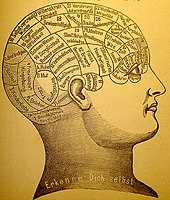
Photo from wikipedia
Human eyes convey a remarkable variety of complex social and emotional information. However, it is unknown which physical eye features convey mental states and how that came about. In the… Click to show full abstract
Human eyes convey a remarkable variety of complex social and emotional information. However, it is unknown which physical eye features convey mental states and how that came about. In the current experiments, we tested the hypothesis that the receiver’s perception of mental states is grounded in expressive eye appearance that serves an optical function for the sender. Specifically, opposing features of eye widening versus eye narrowing that regulate sensitivity versus discrimination not only conveyed their associated basic emotions (e.g., fear vs. disgust, respectively) but also conveyed opposing clusters of complex mental states that communicate sensitivity versus discrimination (e.g., awe vs. suspicion). This sensitivity-discrimination dimension accounted for the majority of variance in perceived mental states (61.7%). Further, these eye features remained diagnostic of these complex mental states even in the context of competing information from the lower face. These results demonstrate that how humans read complex mental states may be derived from a basic optical principle of how people see.
Journal Title: Psychological Science
Year Published: 2017
Link to full text (if available)
Share on Social Media: Sign Up to like & get
recommendations!